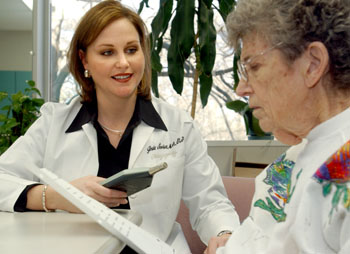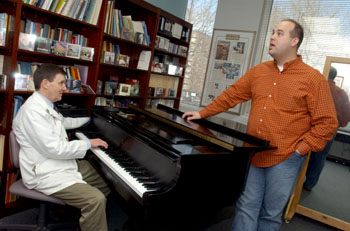
Libby Sanders doesn’t know how loudly she can talk. Parkinson’s disease slowly erodes her volume. Speech pathologist Josie Sevier helps her pipe up. (photo by Dana Johnson)
Specialized speech therapy has broad range

Tom Cleveland, Ph.D., rehabilitates the singing voice. "Some let the sound drive the voice," he says. Here he works with Drew Cline. (photo by Dana Johnson)
The speech pathologists in the Vanderbilt Voice Center have been compared to physical therapists in an orthopaedics practice: they work one-on-one with the patients, educating and training them to use their voices most efficiently before and after—or often in place of —surgery.
The analogy suits Libby Sanders. “I’m like the champ,” the septuagenarian says, her voice barely audible, rough, like the sound of wet sand. “Like Muhammad Ali,” she says, and you crane your neck to listen for more, but she doesn’t readily elaborate.
Sanders is a low-talker. Like her pugilistic pal, bradykinesia, a symptom of Parkinson’s disease related to low dopamine levels, threatens to knock out her voice entirely, slowly diminishing its volume.
Sanders is in good company, besides the Great One. The Voice Center may be known as a highly profiled clinic for country music stars. But Sanders’ speech pathologist, Josie Sevier, is just one of six who specialize in a specific voice disorder.
“Not many places in the country do this,” says Tom Cleveland, Ph.D., associate professor of Otolaryngology and interim director of vocology at the Voice Center.
Cleveland and speech pathologist Melissa Kirby conduct therapy for professional singers, from helping them reduce the size of a bump on their cords to providing voice rehabilitation after surgery.
Kirby also evaluates patients with velo pharyngeal, or cleft, palate, to help determine if their anatomy and speech patterns warrant surgery.
Melanie Hudson, who has master’s degrees in music and speech pathology, mostly sees patients who have had their larynx, including their vocal cords, surgically removed, usually as part of cancer treatment. She teaches patients three new speaking methods: with standard esophageal voice, the most difficult, patients catch air at the back of their throats and “burp” words; tracheoesophageal voice uses a prosthesis that directs air from the trachea to the back of the throat; and the artificial larynx, a vibration device that’s held to the throat, where the larynx would be, and produces buzzing speech when someone mouths words.
Speech pathologist Molly Kilgore adds a holistic approach to voice therapy with laryngeal manipulation and massage. In conjunction with other modalities, patients with muscle strain and dysphonia become aware of their tension, their breathing, and how to relax to use their voices more efficiently.
Sevier’s patients, Sanders included, need help increasing their volume. She teaches an intensive four-week program that brings patients in four times a week for an hour. Sevier measures vocal output in decibels, not only marking their progress but also increasing their awareness. “They don’t perceive how quiet they really are,” she says.
The goal isn’t to position Sanders to compete with Letterman, but to equip her with a way to function. “It’s to increase her volume so people can understand her most of the time,” Sevier says.
Without a voice, people with Parkinson’s tend to become isolated socially. Sevier is helping foster Sanders’ independence, from being able to order a Frosty at Wendy’s, which she tries out after every therapy session, to calling for help.
Sevier has Sanders read a list of functional sentences—such as questions like “what time is it?”—aloud, and has her hold a sound as loud and as long as she can, measuring her volume with a sound level meter. She instructs her how to speak louder, to increase her “voicing” effort in order to override the weakness that many Parkinson’s patients have learned to accept , Sevier says.
Sanders says she expects the therapy to help her. “I lost my voice every time I turned around,” Sanders says. She didn’t expect it to be a consequence of the disease. But she’s eager to learn. And it helps she has a sense of humor. “Sometimes (not talking loudly) helps, when the telemarketers call,” she says.
“You’re getting louder every day,” Sevier tells Sanders.
“Good,” Sanders returns, in a whisper.
Sevier: “What?”
Sanders: “Good!”













